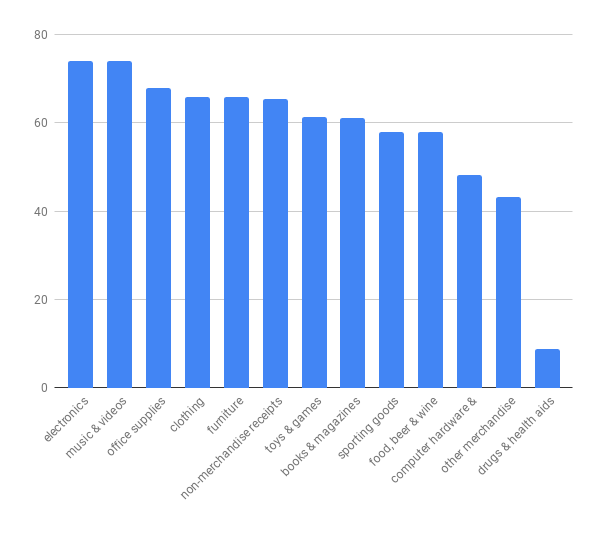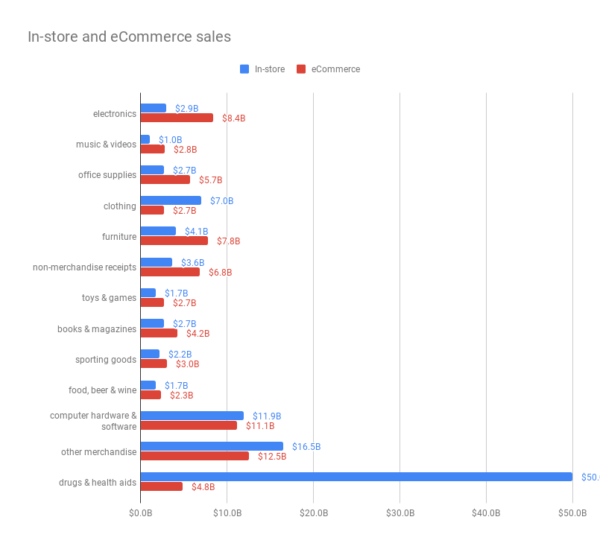The line between traditional and online businesses is becoming increasingly more blurred. The importance of the Internet in people’s purchasing habits is constantly growing and the US Census Bureau estimates that online retail sales are just getting started. It’s not too late to add a web store to your brick and mortar store!
According to initial estimates, online businesses in the US generated 474 million dollars in turnover in 2018; the industry is expected to grow by 20% by 2022. Why would you want to miss out on the ride of a lifetime?As Erply’s customer, you are among the winners – we just improved our Shopify module. The module is a comfortable tool to quickly set up your web store. We elaborated on
how to link your Erply POS to Shopify here
.
This time we’ll concentrate on what you should pay attention to when opening your web store.
How Can You Benefit From a Web Store?
The primary advantage of a web store for a retailer is significantly lower upkeep costs compared to a traditional store. However, the list of advantages for customers goes on: time saved while shopping, open 24/7, wide selection, everything can be accessed from one location, no queues, etc. You can develop your own web store, but it’s much simpler for a beginner to use a readymade platform that only requires you to design the storefront and launch the store.
One such option is Shopify
that has become the gold standard for web platforms. In essence, Shopify is a vast mall where each retailer can open their own store or booth. Shopify will take care of administration and collaboration with suppliers, and make sure that all payment systems are operational.
Shopify’s two-week free trial period also speaks to its advantage. The platform has unlimited product and file space, and it can be used to create new pages, host a blog and direct traffic to your Facebook or Pinterest page. You also have access to more than one hundred Shopify apps.
To reach a broader audience, your platform absolutely has to be optimized for smartphones – according to eMarketer, 59% of all online purchases in 2017 were made using a smartphone. Shopify allows customers to shop from the device of their choosing.
What Are the Costs of Running a Shopify Web Store?
Shopify presents you with around ten free storefront designs, each with two to three varieties, to help you design your web store. If you have specific requirements and want something different, you can order a custom design for your web store for an additional fee (from $80 to $160–180). Speaking of expenses and running costs, the basic Shopify beginner package has a monthly fee starting at $29 plus transaction fees (2.9% + 30 cents); the basic retailer package starts at $79 per month (plus transaction fees 2.6% + 30 cents).
Erply and Shopify
make customer payments incredibly simple and you can use any payment method of your choice (PayPal, Visa, Amex and MasterCard are most common).
Shopify charges a service fee of 0.5–2% on each purchase made on your web store. For an additional fee you can also purchase a variety of systems and apps that simplify web store administration and make the store more comfortable for your customers.
To sum up, Shopify’s advantages include:
- Easy to use for beginners;
- Ideal for selling both digital and physical goods;
- Access to warehouse management;
- Payment and delivery options;
- Social media interface;
- No technical issues.
how to link your Erply POS to Shopify
.
Things to Consider Before Setting Up Your Web Store
Before you add the Shopify module to your Erply account, you should create a strategy detailing each step towards reaching your goal and your web store’s target audience.
What Do People Buy Online?
The survey conducted a couple years ago by the US Census Bureau shows the percentage of purchases made online. The proportion of online sales compared to physical sales

Attributing monetary value to the market shares is especially interesting and allows us to see the actual sums involved.

If we take a closer look at the numbers and rankings, it’s safe to say that the food and beverage, and food supplement sectors have plenty of growth potential in online commerce.
It’s clear that there’s plenty of space online for everybody. This, however, means that factors that don’t come into play in a brick and mortar store need to be taken into account when running an online store – the store’s design and UX, online marketing, etc. Let’s take a look at some of the key factors you should pay attention to when setting up your web store.
Design and User-Experience
You should go over the structure of your webpage in great detail to guarantee that every visitor understands your page in the same way. - Group your products so they’re easy to find;
- Provide as much information about each product as possible (from the ingredients to how the product will be delivered to the customer);
- Upload plenty of photos because that’s what people see first before moving on to the product description;
- Provide a clear overview of your store’s shopping and payment procedures.
Choosing a Domain Name
The domain name must be short, concise and catchy. - The name should be directly linked to the name of your web store;
- The name could be something that describes the products you sell, e.g. a key word based domain name guarantees that your store is easier to find on Google;
- Keep the name short (up to ten characters), simple (make sure that people won’t accidentally misspell it) and unique (make it catchy);
- Avoid similarities with popular brands to prevent potential disputes and fines for breaching a trademark;
- You might also want to check that the name is available on Facebook (this will give you an advantage in making a name for your brand);
- Don’t forget that you’re probably going to have to pay an annual fee for a custom domain name.
Legislation and Rights
Consider which images, background music, etc. you’ll be using. This won’t be a problem with Shopify, which provides you with plenty of themes to choose from. Some basic themes are available for free while the majority of the more individual ones can be purchased for a reasonable monthly fee. However, if you have a clear vision and want to use other images or music, you’ll need to sign a contract with the author, transferring the copyrights to your store.
If your web store has a specific and working trademark, you should patent it – a successful store might attract fraud.
Activate Your Marketing Tools
As mentioned above, Shopify allows you to start a blog on your store platform, providing you with a powerful tool for generating traffic. All you need to know is the target group of your store and how to address them. In addition to your blog, you should also maintain an active presence on social media, e.g. Instagram, Facebook and YouTube. Other powerful online marketing tools include SEO and
Google AdWords
. SEO or search engine optimization helps guarantee that your store is among the first to pop up on Google. Several factors contribute to SEO, e.g. word choice, wording, links between sub-pages, the number of external links to your page, etc. Google AdWords allows you to create and display your company’s ads on Google. This means that a person who visits your page will see your ads on other websites, Facebook or apps. But remember,
Google AdWords is not for free
.
Web stores often wither because of a lack of marketing – you can’t just set up a store and expect customers to find it. Do your homework while setting up a web store!
Of course, you can always buy banners and ads on other websites, but you should know that the effect of banners is on a downward spiral since users have developed so-called banner blindness. Thus, take the calculated and deliberate approach to building your web store and make sure you have a great strategy to reach your customers.
To Sum Up: Remember These Three Key Points
- Compile the terms and conditions of your web store (prices, products, orders, guarantees, returns, claims, payment methods, delivery, liability, etc.).
- List your company data on your website (the more data you provide, the more reliable you seem).
- Don’t forget great customer service (consider adding a live chat option or phone number in addition to your email address).
Erply’s Shopify module
today!
Contact Erply 855-GO-ERPLY (+1 855 463 7759) or support@erply.com to acquire the module.